
Sensor coils with ferrite cores from NEOSID offer tamper-resistant consumption measuring of water, air, steam, gas or any other media with impeller flow meters.
Considering application-related specifications regarding design, geometry, size and material we build the optimal component using the ferrite core and the winding. The result is a sensor coil with the highest resistance against technical manipulation.
With our wide range of different soft magnetic core materials we have the best conditions to design specific sensor coils to satisfy even the most challenging sensor applications.
Sensor Coil Technology for Flow Meters
1. Technical task
In many areas around us, various substances are transported by respective systems. For this purpose, liquids like water as well as air, steam or gases flow through appropriate pipework systems. In many cases a suitable way to record the volume flow or the flow quantity is required, particularly to work out a consumption value. The results are used, among other purposes, as the basis for customer cost calculations.
The requirements of such a measuring process are manifold, which is why different measuring techniques have been developed for recording purposes depending on the application.
2. Measuring process
When it comes to measuring flow quantities in private households, impeller flow meters are predominantly used. These are hermetically sealed flow transducers, whose core element is an embedded impeller which is set into rotation by the respective flow medium. This rotary movement drives the counter in a dial gauge, from which the consumption data can be read out.
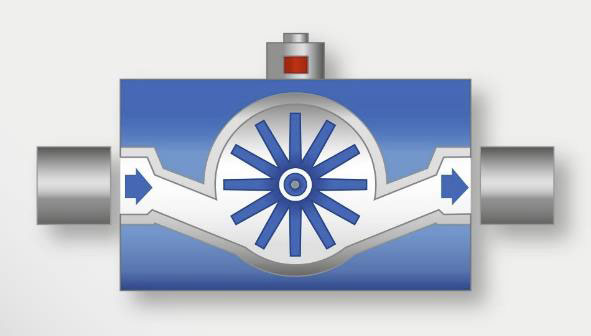
- Impeller flow meter
3. Composition of an inductive speed counter
Speed counters with an inductive operating principle are familiar from a wide range of applications and industrial areas. In this case a rotating metal object, e.g. a gearwheel or impeller with a metallic attachment, is moved by the electromagnetic field from a sensor coil. That leads to a change in the electrical properties of this electronic component and the related electronic circuit delivers an output signal that has been modified accordingly. A passive or microprocessor-based electronic evaluator generates consumption information from this signal modulation. The result can be shown on a display or transferred to a processing unit by an intelligent protocol. Data transfer can be realized by a wired or a wireless interface using transponder antennas.
4. Magnetic manipulation
Dial gauges with magnetic or electromagnetic components can be influenced by a permanent magnetic field set up from outside. This is used, for example, to disable the magnetic coupling between the impeller and the counter. As result the impeller in the wet part moves with the flow of the medium but the consumption counter is switched off.
When recording speeds using sensor coils, the highest possible withstand to permanent magnetic fields should be sought. The optimal design of the sensor coils will then make any manipulation much more difficult or even impossible.
5. Technical background/influencing factors
The function of ferrite-based inductive components is essentially determined by the hysteresis curve of the ferrite material. This takes the following course:
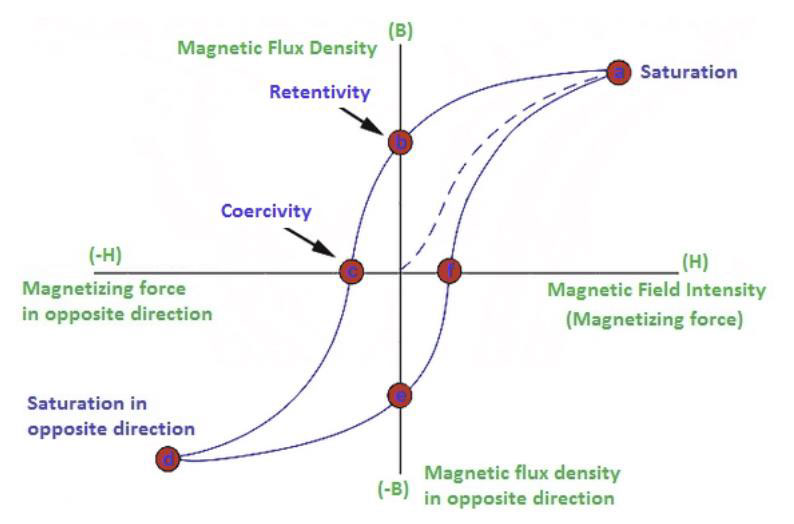
- Hysteresis loop
When developing sensor coils as an electronic component the electromagnetic behaviour of the entire device is defined according the hysteresis loop of the core material.
An external permanent magnetic influence causes additional component load. To determine the total load on the component, the individual loads must be looked at simultaneously. The aim is to ensure proper sensor operation with and without external magnetic Manipulation. If this is achieved the sensor will work over the whole operating range.
Basically, any core can be saturated by a correspondingly strong external magnetic field or even by a self-induced magnetic field. Cores made of different basic materials, mixing ratios and processing methods sometimes demonstrate very different properties with regard to the level they can be magnetically influenced.
Typical ferrite materials such as manganese-zinc or nickel-zinc ferrites have induction values of 200 to 500 Millitesla in the saturation range. Other soft magnetic materials - such as the NEOSID composite material PFS3 - offer values of over 1,000 Millitesla here. This means a wider operating range can be implemented.
Different core materials also have different frequency behaviours. It is therefore important to match the selection of a suitable core material to the operating frequency of the sensor system.
The maximum operating temperature is a result of the installation point ambient temperature and self heating due to current flow. Material-specific limits must not be exceeded for a reliable operation.
The following requirements are generally made on sensor coils in these applications:
- Resistance to static magnetic field
- High Q-factor
- Low winding resistance
- Optimal design of the core shape and the winding
- Suitable operating frequency
- Compliance with operating temperature limits
6. Component and material selection
Starting from an assumed available space, different variations regarding
- core shape
- coil shape
- winding design
have been evaluated.
Selected ferrite core materials from the NEOSID product range:
- Manganese-zinc ferrite F02
- Manganese-zinc ferrite F08
- Nickel-zinc ferrite F2
- Nickel-zinc ferrite F2a
- Nickel-zinc ferrite F20
- Composite material PFS3
7. Measurement results, conclusion
As part of the product development process, the influence of an external magnetic field on the saturation properties of cores made of the above-mentioned ferrite and composite materials is investigated in various series of tests. During this process, according to the application the sensor coils are simultaneously driven with a varying magnetic field, which represents the wanted signal. The resulting inductance values are measured.
To optimise the overall system, many different influencing factors must be taken into account. In addition to dimensioning and material properties of the sensor coils also available installation space inside the dial gauge housing is a limiting factor.
For the specific development of sensor coils, it is therefore necessary to bring together expertise in the field of electronic components and ferromagnetic materials. A wide as possible selection of different core materials is also an important parameter to be able to offer the best solutions for all application-specific differences.
A suitable manganese-zinc or nickel-zinc ferrite material at the specified operating frequency, has a particularly good relationship between material-specific permeability and the magnetic losses: i.e. it provides a particularly high magnetic quality factor which means it is much more difficult to achieve magnetic manipulation.
Other materials, like the NEOSID composite material PFS3, have a higher saturation flux density as described above. However, sensor coils constructed using this core material require a larger installation space to achieve the same inductance values. Material and circuit-specific ancillary conditions must therefore be harmonised to develop the right sensor device for the relevant sensor application.
8. Example part sensor coil Rd 5
Taking the aforementioned aspects into account, we developed the Rd 5 product family for use in impeller dial gauges.
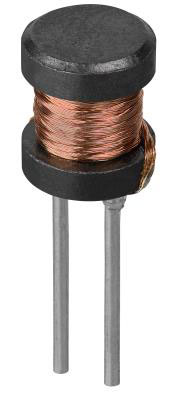
- Sensor Coil Rd 5
Typical electrical values:
- Inductance L = 50μH
- Quality factor Q > 200
- Operating frequency fB ≈ 600kHz
This inductive sensor is integrated on the counter's electronic control system in such a way that a metallic impeller can be directly scanned. Different, application-related variations can be implemented, e.g.:
- Versions as a THT or SMD part
- Individual inductance values
- Change of the core shape according to customer requirements
- Various winding wires
9. Alternative flow meter with electromagnetic components
Beyond the flowmeter versions described above, other volume flow meters are employed using electromagnetic components in the measuring principle. The magnetic-inductive flow meter design should be mentioned here first and foremost.
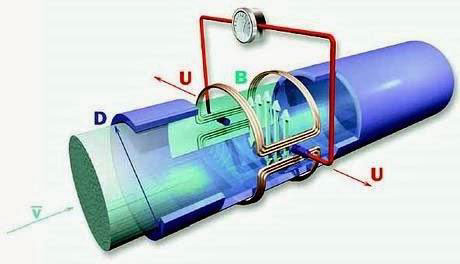
- Magnetic-inductive flow meter
This systems work inside the medium being measured without moving mechanical parts. The consumption amount is recorded by means of a magnetic coil in a sealed pipe. For these measuring systems, NEOSID supplies inductive components in various types with and without cores made of ferrite and other materials. We use highly automated production facilities for different types of components to produce high-volume series quantities.
10. NEOSID competence
NEOSID is available as a competent development partner for a diversity of electromagnetic components usable in flowmeter applications. Our experience in theoretical design, material selection and simulation support is a more valuable advantage for you as our customer. Building of prototypes and bringing the developed part from sample status into high volume production are important factors for a successful product design. Experienced engineers and scientists are on hand for all the development and production steps to provide you, the customer, with an perfect end product from a single source.
It is often necessary for the ferrite core in the sensor coil to be made into a special shape. If this is too demanding to be produced using presses, then we use a special injection moulding process, which gives us much wider options in terms of shaping:
- Ferrite material thicknesses from 0.2 mm
- Core volume from 1 mm3 to approx. 8000 mm3
- Standard tolerance ±2 %, can be partly reduced to ±1 %
- Over 20 different ferrite raw materials
- Permeabilities μi from 8 to 2000
- No mechanical finishing such as grinding or milling required
- Direct winding of the ferrite cores without insulation film
- Metallisation of ferrite materials
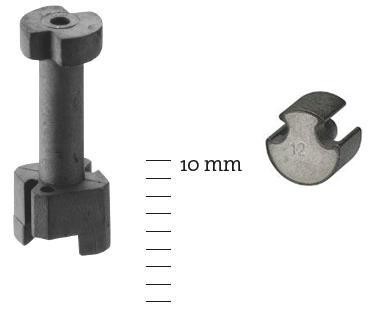
- Example of single-part ferrite cores
These advantages allow complex custom ferrite cores to be produced, providing the basis for the manufacture of tailor-made electronic sensor coils for modern consumption counter for e.g. water or gas.
With regard to electrical efficiency, mechanical stability and perfect integration in the meter housing, these solutions represent a considerable development for this product segment.
We use latest simulation tools to verify core and component development results as fast as possible during the development process.
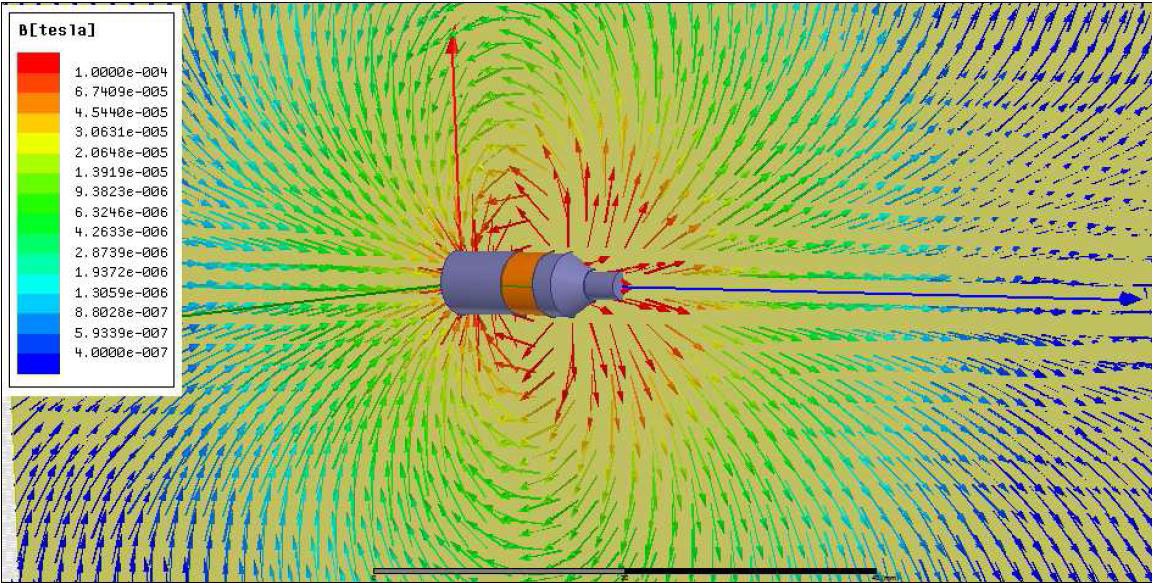
- Simulation result of a sensor coil
Our manufacturing facilities work with state of the art production machinery thus ensuring cost-effective production for different batch sizes. A high manufacturing and testing depth ensure an extremely high quality standard with consistent results across the entire product life cycle.
Tell us your product requirements – we will offer you the perfect solution !
Have we aroused your interest? Then get in touch with us about inductive sensor components for your meter application.







